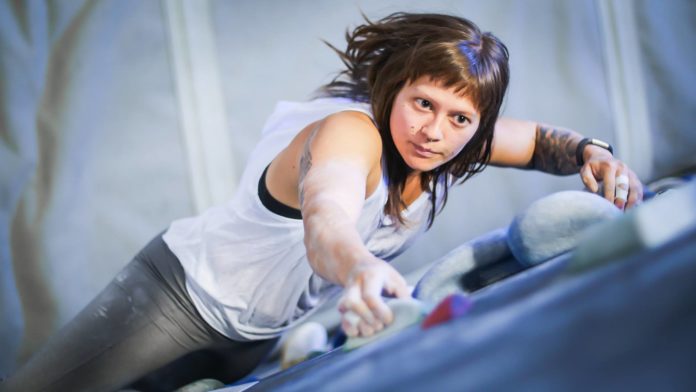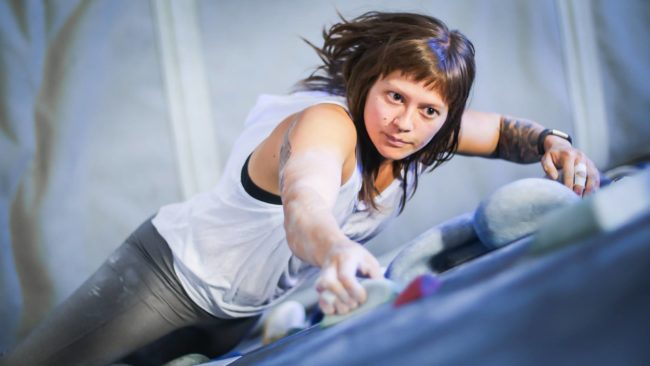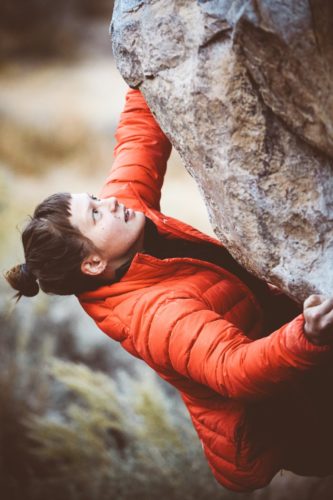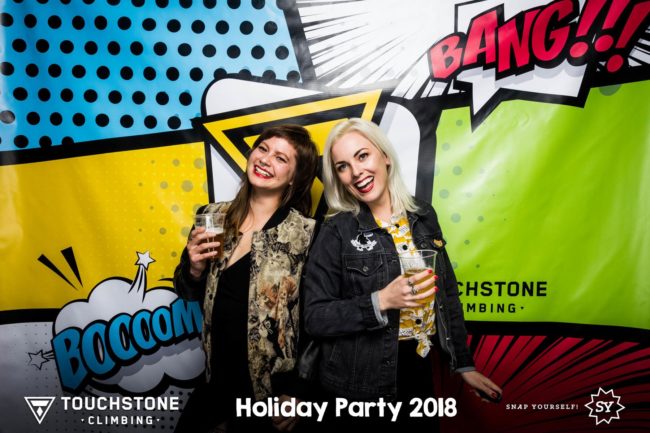
Behind the Desk…is an ongoing series that interviews people influencing and advancing the climbing industry in gyms around the country. This time CBJ explores one of the largest collections of gyms in the country, Touchstone, and talks to one of the key persons behind the company’s community engagement and ongoing stewardship efforts.

Name: Mailee Hung
Title: Director of Communications and Community Engagement, Touchstone Climbing
Location: California
CBJ: Please tell me a little bit about your climbing background and how you found your way to the Touchstone family?
HUNG: I grew up in the California Bay Area and was introduced to climbing through a friend in high school. He brought it up as a fun thing to do after school one day and I was like, “Whose birthday party is it?” We ended up driving 30 minutes nearly every day that year to hit the closest climbing gym.
I more or less gave up on gym climbing in undergrad, but after I graduated I started bouldering outside at Castle Rock State Park near Santa Cruz, California. That’s when I really fell in love with it. A couple years later I got into grad school in San Francisco and applied to work the front desk at Dogpatch Boulders. I worked there part-time while I earned my Master’s. After I finished grad school Touchstone hired me on full-time as their copywriter. The rest is history!
CBJ: Your official title is Director of Communications and Community Engagement. That’s fairly unique, meaning it’s not a formal role that many other gyms have. So, what does it mean, and how do its duties differ from those of, say, a typical gym manager?
HUNG: Touchstone managers are all pretty self-sufficient, but it is a lot to run a gym. The director roles exist to support all of our managers in various capacities. Community engagement is one of our core values—we’re a company full of climbers who all know firsthand how transformative rock climbing can be, so it’s a priority for all of us to try and make it as accessible as we can.
Part of my job is to help managers identify groups in their neighborhoods that could be good to work with, help them stay engaged in their local communities, and share ideas and resources. At our corporate office we’re a pretty tight team with a fair amount of job overlap, so we’re able to collaborate and come up with company-wide or big-ticket events, like our Pride Month celebrations, Access Fund or stewardship fundraisers, the Woman Up Climbing Festival, etc.
CBJ: Your previous title was Outreach and Communications Director. What are some keys to community engagement —or “outreach”—that might be unique to a climbing gym?
HUNG: Climbing gyms are amazing conduits to the outdoors because they give people an opportunity to gain skills they can use outside (if they want!) while remaining really logistically accessible—you don’t have to leave the city to climb anymore. And I’m sure I don’t need to wax poetic here about how great climbing is for physical and mental fitness, emotional regulation, fear management, confidence, and so on, for people climbing at every level. It’s just such an amazing activity that really can benefit anyone.

But I think we need to be conscientious of how climbing looks to people currently outside of the community. While cost is a barrier to entry for some, the bigger issue tends to be the perception of climbing and climbing culture. I like to compare it to polo. Someone can tell you that polo is totally life-changing and they’ll give you a horse and all the gear and teach you how to play…but I mean, can you see yourself getting into polo? There’s a difference between accessibility and inclusion. So when we’re introducing new climbers to our gyms, we try to be cognizant of ‘soft’ barriers that go beyond just being unfamiliar with the activity.
As a side note, we are moving away from the term “outreach,” since it can connote an uneven power dynamic where one party expects the other to conform or assimilate rather than an equal exchange. We now prefer “community engagement,” but given that “outreach” is so entrenched in the lexicon we’re trying to balance embracing new terms while keeping our programs easy to learn about and find via search engines.
CBJ: One aspect of Touchstone’s communication is its breadth of social media—Facebook, Twitter, Instagram, and YouTube—all of which are quite active. What’s the secret to maintaining such substantial social media? Does that all fall onto your shoulders, or is there a whole communications team?
HUNG: No secret, just our incredible Marketing Director and Graphic Designer, Heather Bellgreen! She’s the mastermind behind our social media presence. She’ll task me with specific duties and I’ll do most of the marketing copy (and the gyms are largely responsible for managing their own social media), but for the most part if we’re doing anything right marketing-wise I’d say it’s all her!
I think people have this idea that Touchstone is this massive operation, but it’s really not. There are like nine of us at the office and that’s it. But we’re a really tight team, so I’d like to believe that some of that impression comes from us working so well together.

CBJ: Touchstone is getting ready to open a new facility, Pacific Pipe. What will that opening entail in your role, specifically?
HUNG: Part of my role is assessing demographic gaps in gym participation. Moving into a historically Black neighborhood when climbing is still perceived as a sport primarily for white people means that we’re working to be part of the community and not be seen as some weird, niche facility. That includes being particularly mindful of our context and communicative with local schools, neighborhood groups, and community organizations. The same theory applies to all of our locations, but these relationships are all conversations held over time—my role will be helping Pacific Pipe to stay engaged in the neighborhood and recognize opportunities for collaboration and coalition-building.
CBJ: Can you give any advice to other gyms that might read this and want to adopt a role for a Community Engagement director in their facility? What would a job announcement for such a role look like?
HUNG: I think that every gym should emphasize community-centric work—an environment that promotes equity and inclusivity is supportive for everyone, and climbing (like all things) thrives with a greater variety of people in it! Your gyms will be more appealing to a broader audience, and really cool connections can happen between members and partner organizations.
In terms of what a job announcement might look like, that’s kind of hard to say. I think there are a number of effective ways to approach community engagement, and my way is by no means necessarily the best. It might be better to frame it in terms of candidate qualities. Someone who would do well in this type of role would have really clear communication skills and a lot of tenacity and compassion. The goal isn’t getting people to try climbing once and then it’s all on them to come back or not, the goal is to change perceptions—of both the climbers and the gym. You want someone who can relate to the specificities of your location as well as the context of your community partners and prospective members.
CBJ: Touchstone, as a brand, has a lot of locations—Dogpatch and Mission Cliffs in San Francisco, Berkeley Ironworks and Sacramento Pipeworks, Diablo, Metalmark, Cliffs of Id…how do you maintain a wide Touchstone community that encompasses all those gyms? Or, is it more about creating a community and an identity for each individual facility?
HUNG: It’s a little bit of both, I think. All of our gyms are really unique in themselves and we give them the freedom to grow and evolve as they will—we don’t try to control them from the top down. But I also think that our members recognize that they’re part of a bigger community that shares their values and priorities. It is a lot like family—maybe you don’t see each other much or watch the same TV shows, but you always have a place to crash and people who’ve got your back.
Got a cool story? Tell us!
Do you know somebody who works in the climbing industry and would be good to profile in a Behind the Desk segment? (Or, do you work in the industry and have a personal background that you think others would enjoy learning about?) If so, please contact us and tell us about it!

John Burgman is the author of High Drama, a book that chronicles the history of American competition climbing. He is a Fulbright journalism grant recipient and a former magazine editor. He holds a master’s degree from New York University and bachelor’s degree from Miami University. In addition to writing, he coaches a youth bouldering team. Follow him on Twitter @John_Burgman and Instagram @jbclimbs. Read our interview Meet John Burgman, U.S. Comp Climbing’s Top Journalist.








